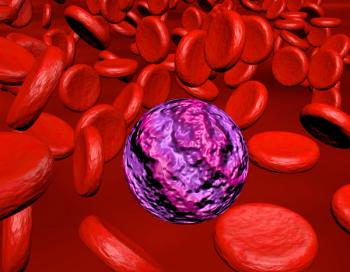
- Oncology Vol 28 No 1S
- Volume 28
- Issue 1S
(P107) Duodenal Sparing Stereotactic Body Radiation Therapy for Locally Advanced Pancreatic Cancer: Technique, Toxicity, and Local Response
The proximity of the pancreas to the bowel presents a unique challenge for pancreatic cancer stereotactic body radiotherapy (SBRT). This study explores the safety and effectiveness of a novel approach optimizing pancreatic tumor coverage and duodenal sparing.
P. Jain, MD, A. Modh, BS, E. Montchal, RN, M. Marrero, MS, V. Vinciguerra, MD, N. Kaushik, MD, J. Knisely, MD, M. Ghaly, MD; Hofstra North Shore-LIJ School of Medicine
Purpose and Objectives: The proximity of the pancreas to the bowel presents a unique challenge for pancreatic cancer stereotactic body radiotherapy (SBRT). This study explores the safety and effectiveness of a novel approach optimizing pancreatic tumor coverage and duodenal sparing.
Materials and Methods: From 2010 to 2013, a total of 30 patients with locally advanced pancreatic cancer (16 head, 13 body, and 1 tail) were treated with SBRT for their unresectable, borderline resectable, or recurrent disease. All underwent endoscopic ultrasound-guided fiducial placement in and around the tumor and had a 4D treatment planning CT scan with oral contrast. This CT was used in conjunction with endoscopic ultrasound (EUS) findings, positron emission tomography (PET), and biphasic CT scans to identify the gross tumor volume (GTV) in the expiration phases. The planning target volume (PTV) was created by expanding the GTV by 2 mm. Dose-volume histogram (DVH) endpoints were constructed, keeping V7, V15, and V20 (stomach/duodenum volumes that received 7 Gy, 15 Gy, and 20 Gy) < 40%, < 25%, and < 15%, respectively; the dose to one-third of the duodenal circumference < 20 Gy; and duodenal point max dose < 23 Gy. Additional dose constraints included liver D50 < 5 Gy, ipsilateral kidney D25 < 5 Gy, and cord Dmax < 10 Gy. Three 10-Gy fractions, normalized to the 85% isodose, were delivered to the PTV on consecutive weekdays using fiducial-based respiratory motion tracking on a dedicated 6 MV linear accelerator (linac)-integrated stereotactic delivery system. The patients were offered systemic therapy for 6 months or until tolerance or disease progression. Follow-up occurred at 4 weeks, 12 weeks, and every 3 months.
Results: All patients completed SBRT and a median of 5 total cycles of pre- and post-SBRT chemotherapy. Planning target volumes ranged from 14–197 cm3 (median 55 cm3). The 12-month survival and local control was 18% and 95%, respectively. One patient developed transient gastroparesis, two patients developed grade 2 abdominal pain, and one developed grade 2 hematologic toxicity. No late toxicity was observed.
Conclusions: Linac-delivered organ-sparing SBRT with chemotherapy in locally advanced pancreatic cancer resulted in excellent local control and was also well tolerated acutely and subacutely. A phase I dose-escalation study is under way.
Articles in this issue
Newsletter
Stay up to date on recent advances in the multidisciplinary approach to cancer.


















































































